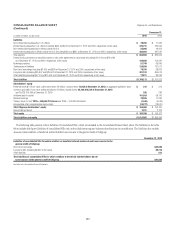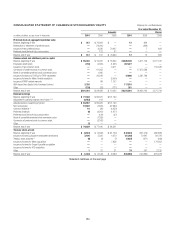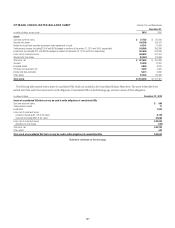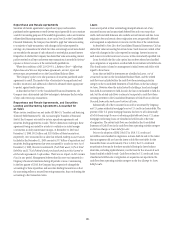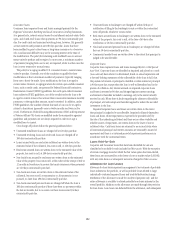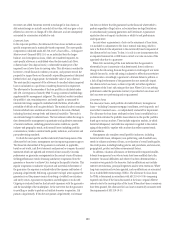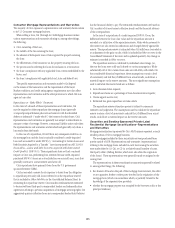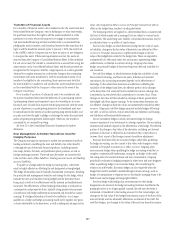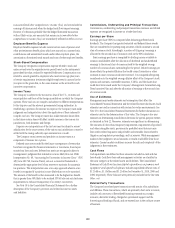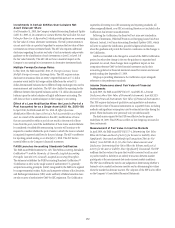Citibank 2010 Annual Report Download - page 164
Download and view the complete annual report
Please find page 164 of the 2010 Citibank annual report below. You can navigate through the pages in the report by either clicking on the pages listed below, or by using the keyword search tool below to find specific information within the annual report.162
Consumer loans
Consumer loans represent loans and leases managed primarily by the
Regional Consumer Banking and Local Consumer Lending businesses.
As a general rule, interest accrual ceases for installment and real estate (both
open- and closed-end) loans when payments are 90 days contractually past
due. For credit cards and unsecured revolving loans, however, Citi generally
accrues interest until payments are 180 days past due. Loans that have
been modified to grant a short-term or long-term concession to a borrower
who is in financial difficulty may not be accruing interest at the time of
the modification. The policy for returning such modified loans to accrual
status varies by product and/or region. In most cases, a minimum number
of payments (ranging from one to six) are required, while in other cases the
loan is never returned to accrual status.
The policy for re-aging modified U.S. consumer loans to current status
varies by product. Generally, one of the conditions to qualify for these
modifications is that a minimum number of payments (typically ranging
from one to three) be made. Upon modification, the loan is re-aged to
current status. However, re-aging practices for certain open-ended consumer
loans, such as credit cards, are governed by Federal Financial Institutions
Examination Council (FFIEC) guidelines. For such open-ended consumer
loans subject to FFIEC guidelines, one of the conditions for the loan to be
re-aged to current status is that at least three consecutive minimum monthly
payments, or the equivalent amount, must be received. In addition, under
FFIEC guidelines, the number of times that such a loan can be re-aged is
subject to limitations (generally once in twelve months and twice in five
years). Furthermore, Federal Housing Administration (FHA) and Department
of Veterans Affairs (VA) loans are modified under those respective agencies’
guidelines and payments are not always required in order to re-age a
modified loan to current.
Citi’s charge-off policies follow the general guidelines below:
Unsecured installment loans are charged off at 120 days past due. •
Unsecured revolving loans and credit card loans are charged off at •
180 days contractually past due.
Loans secured with non-real estate collateral are written down to the •
estimated value of the collateral, less costs to sell, at 120 days past due.
Real estate-secured loans are written down to the estimated value of the •
property, less costs to sell, at 180 days contractually past due.
Non-bank loans secured by real estate are written down to the estimated •
value of the property, less costs to sell, at the earlier of the receipt of title or
12 months in foreclosure (a process that must commence when payments
are 120 days contractually past due).
Non-bank auto loans are written down to the estimated value of the •
collateral, less costs to sell, at repossession or, if repossession is not
pursued, no later than 180 days contractually past due.
Non-bank unsecured personal loans are charged off when the loan is •
180 days contractually past due if there have been no payments within
the last six months, but in no event can these loans exceed 360 days
contractually past due.
Unsecured loans in bankruptcy are charged off within 60 days of •
notification of filing by the bankruptcy court or within the contractual
write-off periods, whichever occurs earlier.
Real estate-secured loans in bankruptcy are written down to the estimated •
value of the property, less costs to sell, at the later of 60 days after
notification or 60 days contractually past due.
Non-bank unsecured personal loans in bankruptcy are charged off when •
they are 30 days contractually past due.
Commercial market loans are written down to the extent that principal is •
judged to be uncollectable.
Corporate loans
Corporate loans represent loans and leases managed by ICG or the Special
Asset Pool. Corporate loans are identified as impaired and placed on a cash
(non-accrual) basis when it is determined, based on actual experience and
a forward-looking assessment of the collectability of the loan in full, that
the payment of interest or principal is doubtful or when interest or principal
is 90 days past due, except when the loan is well-collateralized and in the
process of collection. Any interest accrued on impaired corporate loans
and leases is reversed at 90 days and charged against current earnings,
and interest is thereafter included in earnings only to the extent actually
received in cash. When there is doubt regarding the ultimate collectability
of principal, all cash receipts are thereafter applied to reduce the recorded
investment in the loan.
Impaired corporate loans and leases are written down to the extent
that principal is judged to be uncollectible. Impaired collateral-dependent
loans and leases, where repayment is expected to be provided solely by
the sale of the underlying collateral and there are no other available and
reliable sources of repayment, are written down to the lower of cost or
collateral value. Cash-basis loans are returned to an accrual status when
all contractual principal and interest amounts are reasonably assured of
repayment and there is a sustained period of repayment performance in
accordance with the contractual terms.
Loans Held-for-Sale
Corporate and Consumer loans that have been identified for sale are
classified as loans held-for-sale included in Other assets. With the exception
of certain mortgage loans for which the fair value option has been elected,
these loans are accounted for at the lower of cost or market value (LOCOM),
with any write-downs or subsequent recoveries charged to Other revenue.
Allowance for Loan Losses
Allowance for loan losses represents management’s best estimate of probable
losses inherent in the portfolio, as well as probable losses related to large
individually evaluated impaired loans and troubled debt restructurings.
Attribution of the allowance is made for analytical purposes only, and the
entire allowance is available to absorb probable loan losses inherent in the
overall portfolio. Additions to the allowance are made through the provision
for loan losses. Loan losses are deducted from the allowance, and subsequent



